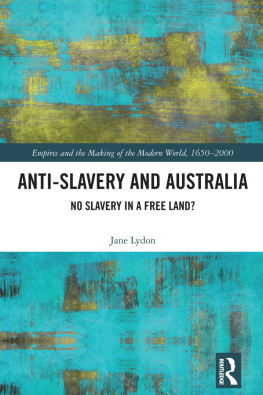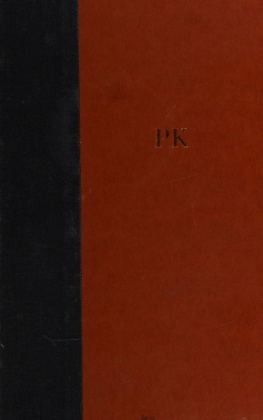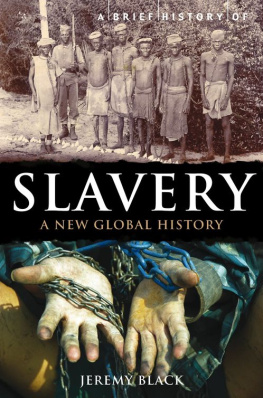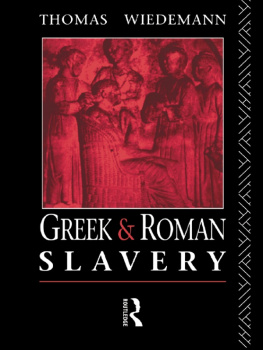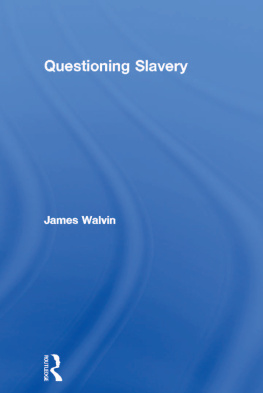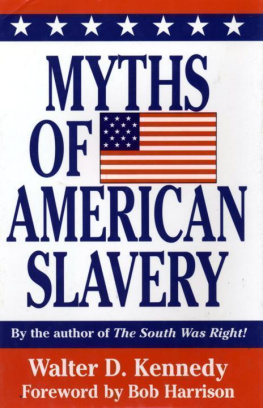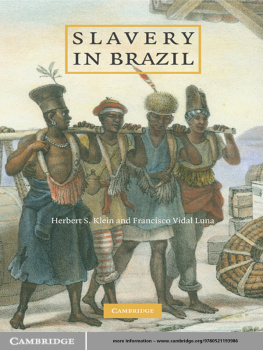THE LEGAL UNDERSTANDING OF SLAVERY
The Legal Understanding of Slavery
From the Historical to the Contemporary
Edited by
JEAN ALLAIN


Great Clarendon Street, Oxford, OX2 6DP,
United Kingdom
Oxford University Press is a department of the University of Oxford. It furthers the Universitys objective of excellence in research, scholarship, and education by publishing worldwide. Oxford is a registered trade mark of Oxford University Press in the UK and in certain other countries
The several contributors, 2012
The moral rights of the authors have been asserted
First Edition published in 2012
Impression: 1
All rights reserved. No part of this publication may be reproduced, stored in a retrieval system, or transmitted, in any form or by any means, without the prior permission in writing of Oxford University Press, or as expressly permitted by law, by licence or under terms agreed with the appropriate reprographics rights organization. Enquiries concerning reproduction outside the scope of the above should be sent to the Rights Department, Oxford University Press, at the address above
You must not circulate this work in any other form and you must impose this same condition on any acquirer
Crown copyright material is reproduced under Class Licence Number C01P0000148 with the permission OPSI and the Queens Printer for Scotland
British Library Cataloguing in Publication Data
Data available
ISBN 9780199660469
Printed and bound by CPI Group (UK) Ltd, Croydon, CR0 4YY
Links to third party websites are provided by Oxford in good faith and for information only. Oxford disclaims any responsibility for the materials contained in any third party website referenced in this work.
Preface
The Legal Understanding of Slavery: From the Historical to the Contemporary is a collection of the work of seventeen scholars, focused on the legal definition of slavery. Using the 1926 definition of slavery as its pivot, the chapters move from Roman law through the abolitionist era to focus on the context in which the 1926 definition emerges, and finally to slavery today. That definition established nearly a century ago by the League of Nations reads: slavery is the status or condition of a person over whom any or all of the powers attaching to the right of ownership are exercised.
The practical outcome of the considerations by leading property lawyers and experts on slavery of that definition is the Bellagio-Harvard Guidelines on the Legal Parameters of Slavery. The Guidelines provide a reading of the definition which is internally consistent with its property paradigm while capturing the essence of contemporary slavery. As a result, the studies in this collection give context and guidance on the application of the definition in cases of modern slavery. While not seeking to establish specific lines as to what is and what is not slavery in a contemporary setting, The Legal Understanding of Slavery details a manner of approaching the definition that provides for the type of legal certainty required in a court of law.
This book is timely, as it appears at a point when there is renewed focus on slavery and trafficking in persons. With this renewed interest comes the push to hold people to account for forcing others into conditions of slavery. Thus the necessity of a study on the definition of slavery is acute as it provides legal clarity to a concept which, until very recently, has not been tried with any great abandon in courts of law. This book is not only the first full-length study of the legal definition of slavery; it is also the only collection that sets out to consider what slavery means in law both in an historical and a contemporaneous context.
The Legal Understanding of Slavery is the outcome of a Research Network which was established as a result of a grant by the United Kingdom Arts and Humanities Research Council. That Research Network comprised two dozen peoplemost represented in this volumewho come from varied scholarly backgrounds. They brought the perspectives of economists, historians, lawyers, sociologists, and political scientists to the table. Of the lawyers, we have an international and Islamic jurist, labour and property lawyers, and legal historians in the mix. Each delivered a unique perspective, adding to a fundamental understanding of what slavery means in law.
The collection brings together iconic names in the study of ownershipthat of Antony Honor, and slaverySeymour Drescher, Stanley L. Engerman and Orlando Patterson; leading light in the property lawJ.E. Penner, legal historyPaul Finkelman and Rebecca J. Scott, and contemporary slaveryKevin Bales; it also gives a place to new voices with the inclusion of an impressive piece of scholarship by the PhD candidate, Allison Mileo Gorsuch, as well as Robin Hickey and Joel Quirk, who joined the Network as young scholars, but have since both been promoted to senior lectureships, which reflects their current status as established, rather than new, voices.
The Legal Understanding of Slavery: From the Historical to the Contemporary is an academic study of the definition of slavery which will attract interest from the leading libraries of the world, its considerations will draw the attention of those studying slavery whether historical or contemporary, in the various disciplines of the social sciences. It will, of course, be of interest to students and staff of law schools, and will draw a global audience of those interested in the law of slavery; social workers, police, prosecutors, judges and policy-makers alike.
Acknowledgements
This collected edition is an outcome of a United Kingdom Arts and Humanities Research Council grant under their Research Network scheme. That grant was the catalyst to bring together two dozen academics and practitioners over a two-year period, to consider the legal definition of slavery.
This project has its roots in the recognition in the 2008 case The Queen v Tang before the High Court of Australia that the 1926 definition of slaveryslavery is the status or condition of a person over whom any or all of the powers attaching to the right of ownership are exercisedhad contemporary relevance as being applicable not only in de jure (as status) but also in de facto (as condition) situations of slavery. The question which lingered was: what constitutes the powers attaching to the right of ownership?
In seeking to consult my property law colleagues in the School of Law at Queens University, Belfast, it was Robin Hickey who immediately grasped the potential of the property law paradigm in thinking about contemporary slavery. While, for technical reasons, I became the Principal Investigator on the Arts and Humanities Research Council (AHRC) grant, Robin was the Co-Investigator whose value-added to the project is immeasurable and whose insights were fundamental to the project. I wish to acknowledge Robinsunflagging support and his growing importance as the project evolved over time. Having created a transatlantic Network, I still marvel at the fact that the linchpin to its success was but a few doors down from my office.
As a harbinger of things to come, Robin and I were given an insight into the academic rigour that would pervade this project when, in January 2010, we took part in the first meeting of the Steering Committee of the Research Network. While that meeting worked through the logistics of how the Research Network might proceed, what was most memorable were the discussions of Antony Honor, Richard Helmholz, and Orlando Patterson of the nature of slavery and Roman law. I wish to thank Guy Goodwin-Gill for facilitating our use of the Hovenden Room at All Souls College, University of Oxford.



